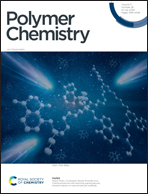Synthesis of well-defined mechanochromic polymers based on a radical-type mechanochromophore by RAFT polymerization: living radical polymerization from a polymerization inhibitor†
Abstract
Mechanochromic polymers that contain a single radical-type mechanochromophore (RM) unit, which generates relatively stable colored radicals by mechanical stimuli, but works as a polymerization inhibitor, were prepared via a reversible addition–fragmentation chain transfer (RAFT) polymerization method. The RAFT polymerization of monomers such as methyl methacrylate, ethyl methacrylate, butyl methacrylate, 2-hydroxyethyl methacrylate, and styrene, in the presence of a diarylbibenzofuranone (DABBF)-based RAFT agent that consists of one unit of the typical RM DABBF and two RAFT agent units successfully proceeded in a living manner to give the corresponding well-defined DABBF-centered polymers (Mn 3000–47 800, PDI 1.12–1.24). Furthermore, a triblock copolymer with RM at the center of the polymer chain was also synthesized by using the DABBF-centered polymer as a macro-RAFT agent. The resulting polymers exhibit mechanochromic properties via the cleavage of the central carbon–carbon bond of DABBF, which was confirmed by solid-state UV-Vis absorption and EPR spectroscopy.



 Please wait while we load your content...
Please wait while we load your content...